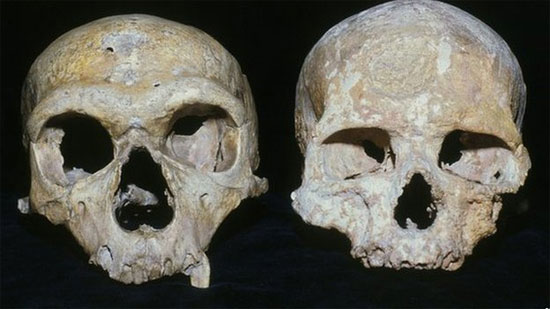Are Neanderthals extinct because their eyes are too big?
A study of Neanderthal skulls reveals that, like this person, extinct because of having bigger eyes than modern humans - our ancestors.
According to a research report published in the journal Proceedings of the Royal Society B Journal, Neanderthals are close relatives of modern people (Homo Sapien), who lived in Europe about 250,000 years ago. Two varieties of humans coexisted and interacted briefly, until the Neanderthals became extinct about 28,000 years ago, partly due to the ice age.
The team examined the hypothesis that the ancestors of Neanderthals had once left Africa and had to adapt to the longer, darker and more gloomy day of night in Europe. As a result, Neanderthals evolved larger eyes and much larger visual processing areas behind their brains.

The Neanderthal 9trasi skull shows their eye sockets larger
much more than the eye sockets of modern people - our ancestors. (Photo: BBC)
Meanwhile, due to staying in Africa, Homo sapien continue to enjoy the bright, beautiful days and thus do not need to adapt to such changes. Instead, our ancestors developed the frontal lobe - the brain region associated with higher-level thinking, before reaching out across the globe.
After comparing the skulls of 13 Neanderthals and 32 Homo sapiens, researcher Eiluned Pearce from Oxford University (England) found that Neanderthals possessed significantly larger eye sockets, averaging more than 6mm afternoon from top to bottom.
Although this eye size difference seems small, Ms. Pearce asserts, it is enough for Neanderthals to maneuver more parts of the brain to process visual information.
'Because Neanderthals evolve to adapt to a higher environment, their brains have to spend more parts for sight and control over the body, making the brain less room for other functions, for example. like a social network , 'Pearce stressed.
This view is supported by Professor Chris Stringer, another member of the research team and an expert on human origin at the British National Museum of History.
'We concluded that Neanderthals possessed smaller perceptual areas in their brains and this may have limited them, including the ability to form larger populations. If you live in a larger community, you need to have a bigger brain to handle all the extra relationships, 'explains Professor Stringer.
The fact that the brain structure focuses more on visual function may also have influenced Neanderthal's ability to create and adapt to the ice age. This is said to have contributed to their extinction.
- New discovery of the end of Neanderthals
- New discovery about the primitive extinct Neanderthal
- Why are Neanderthals soon extinct?
- Are Neanderthals extinct because they are eaten by smart people?
- Discover common ancestors of modern people and extinct people
- Another human being became extinct because of the 'marriage of death' with our ancestors
- A common childhood disease can cause Neanderthals to become extinct
- Ancient remains reveal our 'fishman' ancestors
- The story of our ancestors' love with extinct people
- The cause of Neanderthal extinction
- New discovery of the extinction of the Neanderthals
- We have become more extinct with the Neanderthals than we thought
 Discovered an ancient centipede fossil 99 million years old
Discovered an ancient centipede fossil 99 million years old Discovered bat-like dinosaurs in China
Discovered bat-like dinosaurs in China Discovered a 200-year-old bronze cannon of the coast
Discovered a 200-year-old bronze cannon of the coast Discover 305 million-year-old spider fossils
Discover 305 million-year-old spider fossils